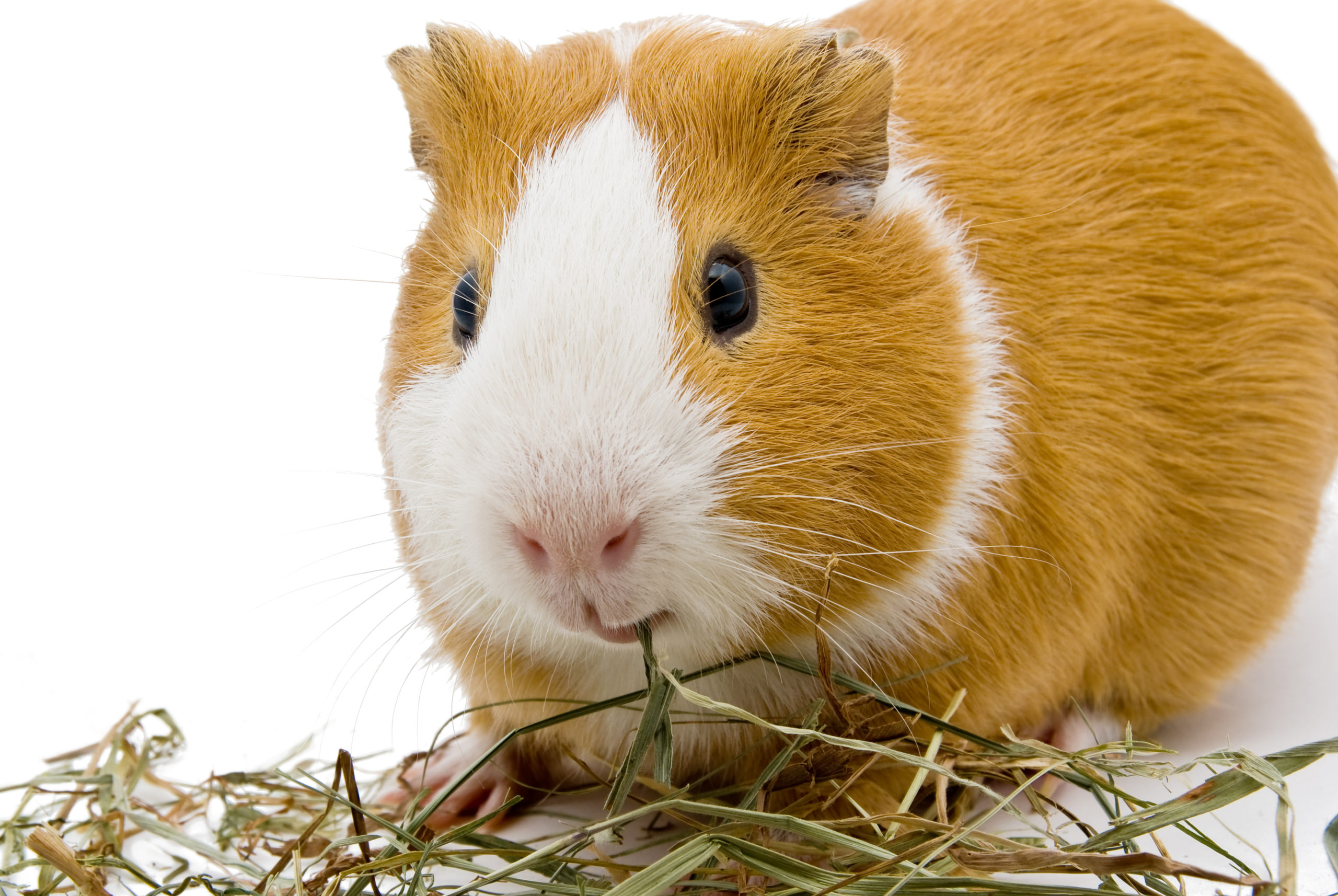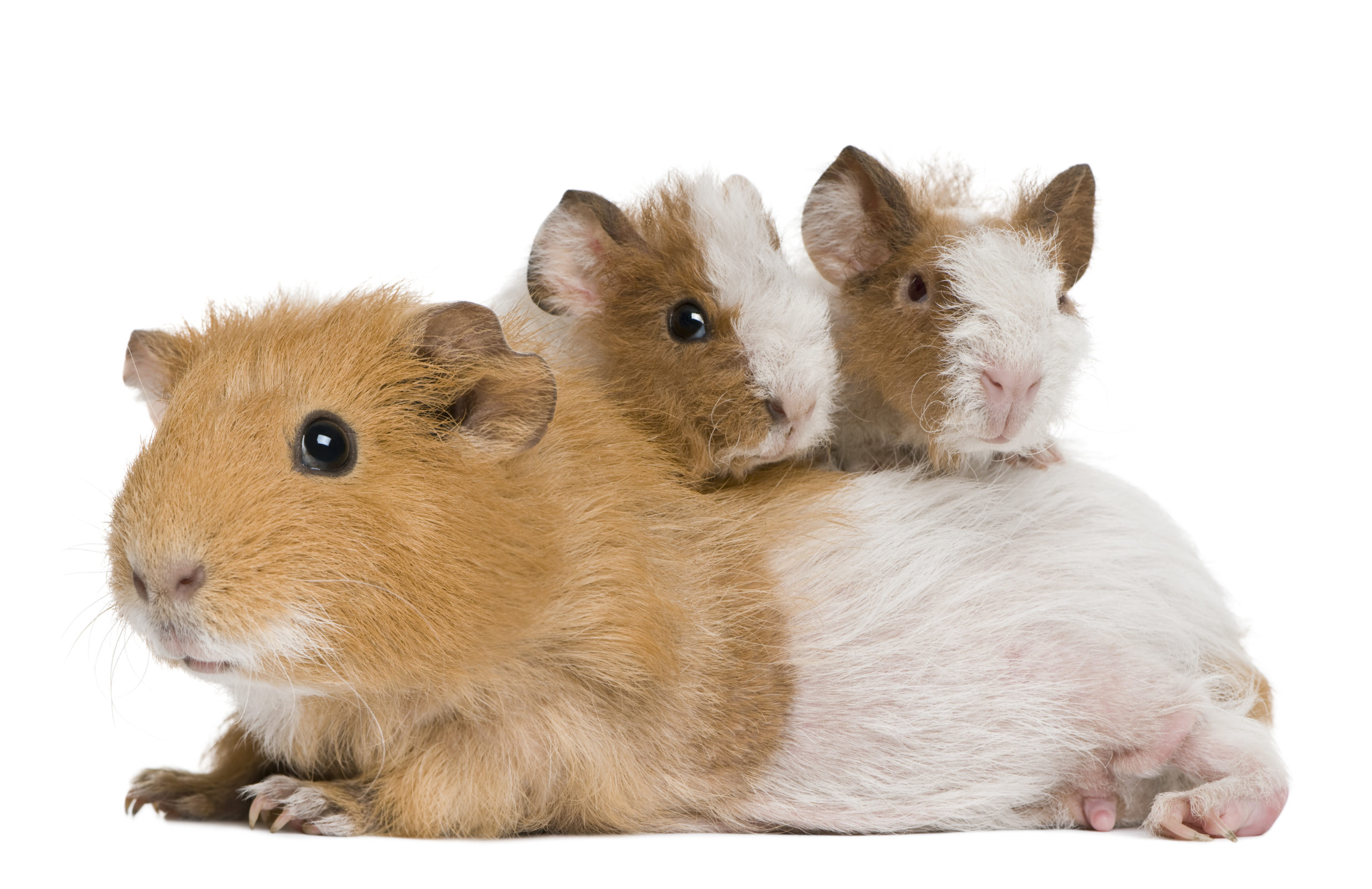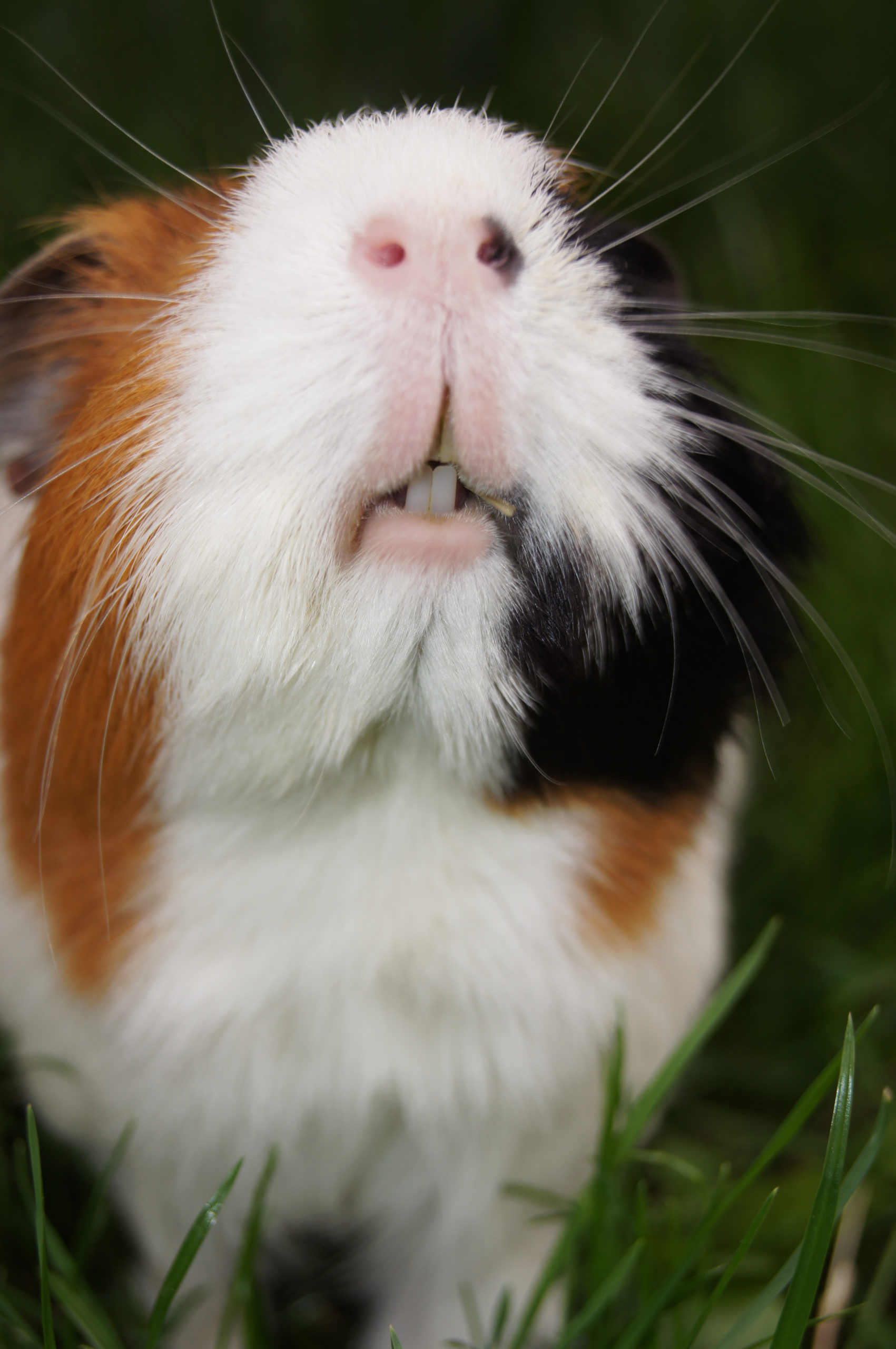I founded and have been the Los Angeles Guinea Pig Rescue director for some time now, twenty-one years in fact. In that time, I have cared for thousands of guinea pigs and learned something from each and every one. The rescue tends to receive many sick guinea pigs, and I have become adept at recognizing common piggy illnesses. We recommend consulting your exotic veterinarian if you suspect your guinea pig is in pain or suffering from an infection or illness.
Outlined below are a few of the more common guinea pig ailments:
Hay Poke
To treat, first, locate the piece of hay. It is easier if you apply some eye lubricant (human eye lubricant works as well) to coax the piece to the surface. Most of the time, you will be able to lift up the eyelid of your squinting guinea pig and may be able to gently pull it out if it's a large enough piece. My recommendation is to apply an over-the-counter medication called Terramycin twice daily.
It is usual for the eye to become opaque in the days afterward. In less than a week, the eye will usually be as good as new, but for now, I like to say that the curtain is closed for repairs behind it.
Lumps
Guinea pigs are "lumpy" loves. They are prone to sebaceous cysts, which are just like pimples, across their bodies. When gently pressed, they may remind you of memory foam. If these stay small, there is no need for intervention. However, if they burst and/or grow too large, the whole sac may need to be removed to prevent infection.
An abscess—though not as common as a cyst—often occurs on their neck area. Draining the abscess and a course of antibiotics is the standard treatment. Mammary gland tumors are most often seen in males over three years old and, unfortunately, require surgical intervention.
Ovarian Cysts
Ovarian Cysts in a female guinea pig can wreak havoc. They generally correspond with age, so older females tend to be the most affected. The most common symptoms include crust around the nipple, hair loss in a V shape on the back, bilateral hair loss on the flanks, and increased dominant female behavior and bossiness.
If ovarian cysts are present, you will need to get an ultrasound to verify no tumors are present. Our rescue's veterinarians perform spay surgeries on some females suspected of having ovarian cysts and occasionally find internal growths and tumors. Without an ultrasound, there would have been no way of knowing, and the tumors and the piggy would not have received the proper treatment. Spay surgery prolongs life (and health) in female guinea pigs.
Ovarian cysts can be managed quite well with hormone injections or hormone implants. Still, tumor growth inside the reproductive system needs to be surgically removed.
Skin Issues
There are a few parasites that can make a home in your guinea pig’s fur. The good news is that most are easy to treat at home. Here are the most common parasites and how to treat them.
Lice
Can be seen with the naked eye. They have a long body and like to lay eggs by the face, on top of the head, and armpits. Human anti-lice shampoo will make short work of those. Regular treatments with Ivermectin will treat and prevent an infestation (species-specific).
Fur Mites
Appear as tiny specks of dirt clinging to the middle and end of the hair shaft. Treatment consists of anti-lice shampoo and Ivermectin (species-specific).
Ringworm
Not actually a worm as its name suggests—it is a fungus. It usually starts on the face, nose, and around the eye, and from there, it spreads. The treatment for ringworm is an anti-fungal shampoo used once a week for three weeks. After that, anti-fungal cream is applied twice daily to the affected areas. It can be transmitted to humans in rare cases, so make sure to wash your hands after treating or handling your guinea pig.
Mange Mite
There are a few different species of ectoparasites that can infest a guinea pig. These mites are microscopic and burrow under the skin, causing severe itching. Treatment consists of Ivermectin (species-specific). Pro-tip: If mange mites and ringworm are suspected, treat both. It can be challenging to differentiate between the two, and the skin scrapings at the veterinary clinic are not 100% reliable. I had seen many instances when the piggy did not receive correct treatment because the scraping did not have a "positive" test result.
Soft Stool
I have found that soft stool often is not food-related. For instance, it may be caused by a stomach bug and require a fecal float and/or culture. Another example, certain medications that can cause diarrhea, such as Baytril. Charcoal therapy has been used to help regulate the bowels.
Teeth (Broken)
Broken front teeth (incisors) are pretty common and not a reason for panic. However, some pigs are cage biters—usually to get your attention because they are after a snack. Others have genetically weaker teeth prone to break (small pieces or all the way down to the root).
Most of the time, you will not even notice it because guinea pig teeth grow back incredibly fast. In fact, in four or five days, the new tooth is pretty much back in place. There is no need to trim the teeth; you can usually just wait for the new short teeth to catch up with the older growth. If the break occurs at the gum line, it will make eating a little more difficult, so be sure to shred or dice fresh foods making them easier to chew.
Teeth (Overgrown)
A guinea pig has twenty teeth, and overgrown teeth can be hard to manage. It is usually an acquired dental disease, meaning it is a symptom—something else is going on in the body for those teeth to overgrow or misalign. It is often tough to diagnose the cause of the issue. Usually, the molars in the back of the mouth will get fixed by the vet only to grow back again in a few weeks. The molars can overgrow to the point that the tongue can be trapped. A guinea pig struggling to eat should be easy to spot. Still, I recommend keeping a weekly weight log to alert you of sudden weight loss that may indicate a tooth problem.
Upper Respiratory Infection
With similar cold symptoms, an upper respiratory infection generally does not go away without antibiotic intervention. It can be recognized by sneezing, wet nose, crusts around the nose, watery eyes, dirty on the inside of the front paws from wiping their nose, and crusty bits around the eye. A broad-spectrum antibiotic—available by prescription only from your veterinarian—is the treatment for this infection.
Urinary Tract Infection, Bladder Stones, and Bladder Sludge
I lumped these three together because if one present, often another is as well.
A urinary tract infection (UTI) usually responds to antibiotics. It can be caused by bladder stones and/or bladder sludge when stones form in the kidney and travel down to the bladder.
It is easier to treat in females than males because females can flush out a stone from the bladder into the urethra and out of their body with a urine stream, quite often undetected by us. In some cases, a small stone can become lodged in the urethra and can be felt with your fingers. Those are easy to remove for a veterinarian. Male guinea pigs are sadly a little more complicated. Their urethral opening is not large enough to let stones pass, and often the only permanent solution is a stone removal surgery. The most typical indication of a bladder stone is your guinea pig hunching over and squealing in pain when urinating.
The condition is easily recognizable with females. The fur around their bottom area should never be wet. Check for any wetness and check for dry or damp clumping of hair underneath their private parts. Suppose you gently pull on a piece of the clumped hair, and it comes out quickly. In that case, it is likely caused by the acid in the urine. The interrupted urine stream made urine trickle onto the skin due to one of the three reasons above. Treatment includes surgery, subcutaneous fluid to try and flush out the stone, antibiotics, and pain killers.
I hope your piggies enjoy a lifetime of good health, but to be safe, you'll want to choose a trusted exotic vet before adoption. Additionally, soon after they've come to their forever home, bring them in for a wellness exam with your vet. Finally, make sure you know where the closest animal emergency hospital is for when your vet is closed. Just like humans, illness can happen at any time.
Much *wheek* *wheek* love,
Saskia Chiesa
Founder/Director, Los Angeles Guinea Pig Rescue
DISCLAIMER: These links are being provided as a convenience and for informational purposes only; they do not constitute an endorsement or an approval by Small Pet Select of any of the products, services or opinions of the corporation or organization or individual.










